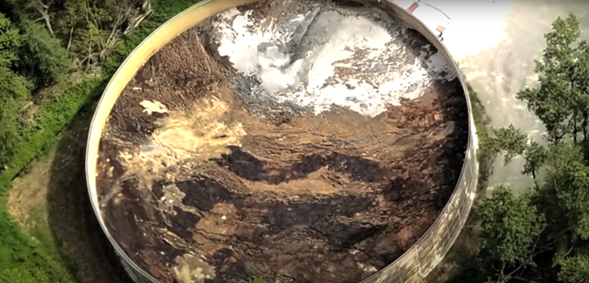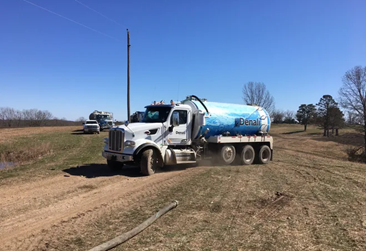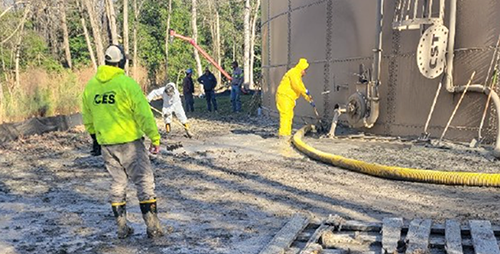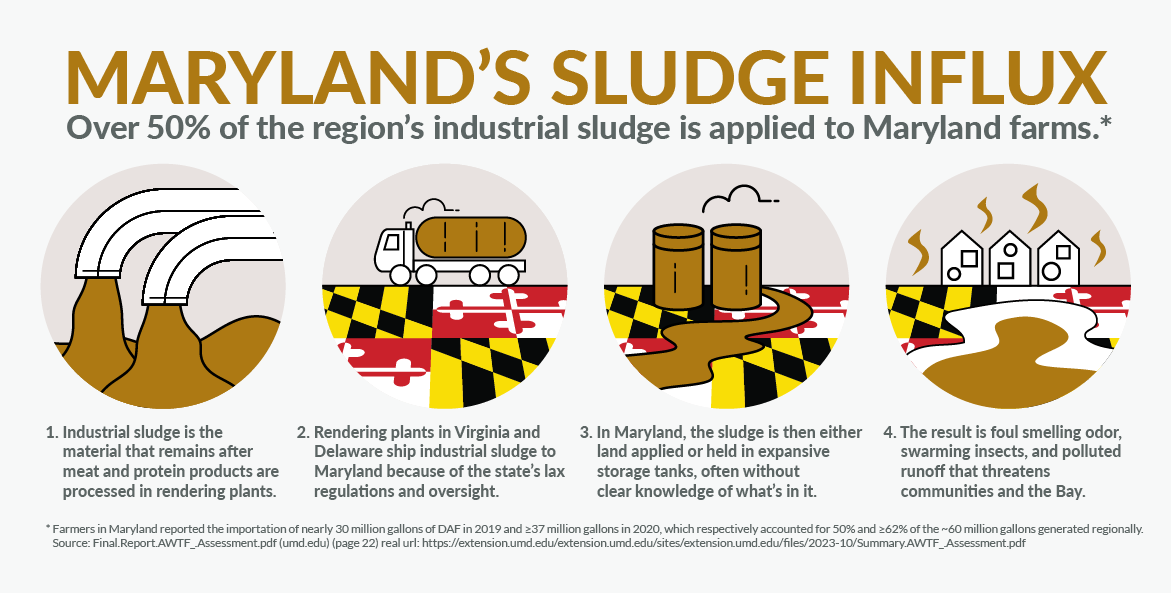When Cheryl Lewis of Talbot County steps out of her front door, she is not met with the fresh air one might expect in rural Maryland. Instead, she's hit with the overpowering stench of "Dissolved Air Flotation" (DAF), a type of industrial sludge that's stored on the farm across the street. Lewis and other neighbors describe the smell as "nauseating," "vomit-inducing," and "like rotting meat and death." In a Talbot County Agricultural Resolution Board hearing in 2022, residents recounted health concerns associated with the sludge, like headaches and dizziness, and even cited instances of children vomiting while waiting for the school bus.
Lewis, who resides on a farm, says the neighboring property has become a storage ground for industrial sludge that's created by industrial processing and rendering facilities. Some examples include the beleaguered Valley Proteins plant (now owned by Darling Ingredients) and Denali Water Solutions, a sludge waste hauler. According to county documents, the sludge near Lewis's house includes seafood remnants and chicken processing byproducts, resulting in the "strong, foul, offensive" odors.
Lax regulations by the state make the Eastern Shore and other parts of Maryland a hot bed for this material to be produced, stored, and eventually applied to farm fields. That's why CBF and our partners are introducing legislative solutions for policymakers at Maryland's General Assembly session this January.
"I'm not just a concerned neighbor," Lewis said. "I have a background in local government and municipal wastewater treatment plants. I'm familiar with state regulations, and I know from the bottom of my heart that what's happening here is wrong and everyone is looking the other way."

Aerial photo of open-top storage unit for DAF materials in Wicomico County, Maryland.
What Is DAF Industrial Sludge?
DAF industrial sludge is the leftovers that remain after protein and other organic materials are processed in poultry, seafood, or livestock rendering plants, sometimes by skimming off solids that float to the top of treatment tanks by a technique called Dissolved Air Flotation or "DAF." Rendering companies like Valley Proteins supply some waste to the pet food market. But the residuals—a highly liquid mix of water and remaining materials like blood, feathers, and other unused bits—create the DAF.
Maryland regulators treat DAF as a soil amendment that may be applied to farmland. However, the material is subject to only high-level annual state testing, so landowners lack information about its make-up.
Even though a 2023 study by the University of Maryland extension, commissioned by the Maryland Department of Agriculture, finds that DAF "may be a poor choice to limit nutrient runoff," land application has become widespread since first approved several decades ago. Compared to poultry litter, which is an accepted crop nutrient source when well-managed, the nitrogen content of DAF was about 10 percent of the amount in all litter spread on Maryland farms in 2019. Nutrient content estimates in the material vary widely, as does the portion that is solid (anywhere from 2-46 percent), making its utility to farmers unpredictable at best. While concerns over the safety and impacts of DAF are growing, no comprehensive public databases track sludge generation, shipment, and composition.
Lucrative Sludge Trade
Matt Pluta, Choptank Riverkeeper at ShoreRivers notes that hauling companies are highly compensated for agreeing to dispose of DAF industrial waste. Sums as high as $2,000 per 10,000 gallons are reported to be paid to commercial waste disposal operations.
"The rendering industry wants to do this as cheaply as possible," Pluta said. "Since the state does not require rendering facility permit holders to fully manage the sludge, they produce onsite, generators like Valley Proteins will pay a premium for 'haulers' to come and remove the sludge from their facility. They'll take way more than they know what to do with, and because they aren't publicly held accountable, we're seeing major mishandling."
In some instances, Pluta said haulers buy their own farmland solely for storage. They also offer farmers financial compensation to apply sludge on their land, creating an incentive to fertilize crops more than state nutrient management rules suggest. This mishandling causes overapplication, leading to runoff that goes directly into the Bay and its tributaries.

Trucks transport DAF materials from rendering facilities in Maryland.
Maryland's "Loophole" Makes the State a Sludge Magnet
Maryland has become a dumping ground for DAF industrial sludge. The University of Maryland study estimates that in 2019 and 2020, 93.9 million gallons of DAF were imported into Maryland, containing 4.78 million pounds of nitrogen and 1.75 million pounds of phosphorus. In other words, more than half of the region's industrial sludge is applied to Maryland farms.
This is due to the lack of Maryland state oversight and regulation, that incentivizes producers from across the region to ship their DAF sludge to Maryland rather than contend with the more stringent laws in neighboring states like Delaware and Virginia, where a permit to transport and spread sludge is required. Farmers and environmentalists fought for years over how best to reduce water quality impacts from the excessive use of poultry litter on farms, eventually agreeing to a major overall to how Maryland regulates phosphorus in farm nutrient management plans. That progress is now being reversed, at least to some extent, by the unregulated waste disposal that again puts farms, rivers, and the Bay at risk.
In Maryland, DAF sludge generators need a discharge permit from the Maryland Department of the Environment (MDE) that regulates their wastewater treatment process. When DAF sludge gets applied to farmland, the Maryland Department of Agriculture (MDA)—which allows the application of DAF as a soil amendment for crops—is responsible for oversight. But there's little transparency around where it goes and what's in the DAF sludge when it's spread on land. The composition of sludge is currently analyzed by the State Chemist only once a year, from samples drawn by the DAF-producing facilities. Once the sludge material is put into trucks and sent away, there is no system that ensures proper handling.
Done properly, sludge would be applied to land only in certain quantities and during certain times of the year to avoid runoff into nearby waterways (for example, not during winter when dormant plants don't absorb nutrients). Unfortunately, in addition to improperly over-applying sludge, handlers are also finding and building places to store it—often in giant open tanks and pits where permitting and regulatory oversight is unclear at best.
These sludge storage tanks harm surrounding communities and environments. Runoff from spills and excessive sludge application pollutes waterways, and the stench is so foul it's becoming a public health concern.

Crews work to clean up a DAF storage tank spill in in Hebron, Maryland.
Maryland Department of the Environment
"The Smell Smacks You in the Face"
Unfortunately, Cheryl Lewis's experience with sludge is not uncommon.
"The smell smacks you in the face," John Hammer said in an article by the Star Democrat. John is a farmer and poultry producer who lives about a quarter mile from a DAF facility in Caroline County.
Caroline County Commissioners passed a temporary mortarium on DAF storage in December 2023 after hearing arguments from concerned citizens, as well as Denali Water Solutions.
"The farm across from us brought in [DAF] material," said George Beston, Caroline County resident. "It was in big mountains of guts and liquid. They spread it; did not inject it. The whole house stunk and was covered in black [with flies]."
Another resident, Gene Myers, added: "It's a decrease of our property value. And all of us are rural residents. We have our own wells. What's it going to do to our water table?"
"The Stream Was Running Black"
Matt Pluta said haulers are so desperate to find places to store sludge, they'll look on satellite maps to identify old dairy farms or lagoons. One property in Caroline County was formerly owned by Hanover Foods, a canned and frozen vegetable producer that stored its waste in the property's lagoon. When sludge haulers bought the lagoon, neighbors downstream almost immediately noticed the sludge entering the local waterway.
"They called me and said the stream was running black," Pluta said.
In addition to stream pollution created by unregulated runoff, Cheryl Lewis expressed concerns for wildlife, which is a key part of Eastern Shore life. Many farmers rely on hunting and fishing for food, and Cheryl has heard concerns from other states where per-and polyfluoroalkyl substances (PFAS), also known as "forever chemicals," have been detected in deer where the application of wastewater sludge is practiced.
"We are now consuming venison that's been drinking from the very creek where runoff from the long-term storage of this waste is entering," Cheryl said.
She added: "The farmers I know have been here for generations, farming this land. Despite the horrendous smell and other challenges, we cannot just leave. This is our home."
Next Steps: Legislation for Better Regulation
Those most affected by Maryland's industrial sludge problem have fought for relief in every way they can. Residents are working together with organizations including the Chesapeake Bay Foundation, Dorchester Citizens for Planned Growth, Chesapeake Legal Alliance, ShoreRivers, and others.
The coalition is now proposing legislative solutions focused on strengthening Maryland's oversight, calling on the General Assembly and agency leaders to require DAF industrial sludge handlers to hold a permit and meet public and environmental health conditions before being allowed to apply sludge to land. Handlers of municipal sludge from sewage treatment plants are already required to operate under similar rules.
Communities have sounded the alarm. It is now up to state legislators and the Moore Administration to stop the influx of industrial sludge for a healthier Bay and for the protection of our local communities.

Maryland Communications & Media Relations Manager, CBF
[email protected]
443-482-2023
Issues in this Post
Economy & Human Health Land Use Runoff Pollution Water Quality



